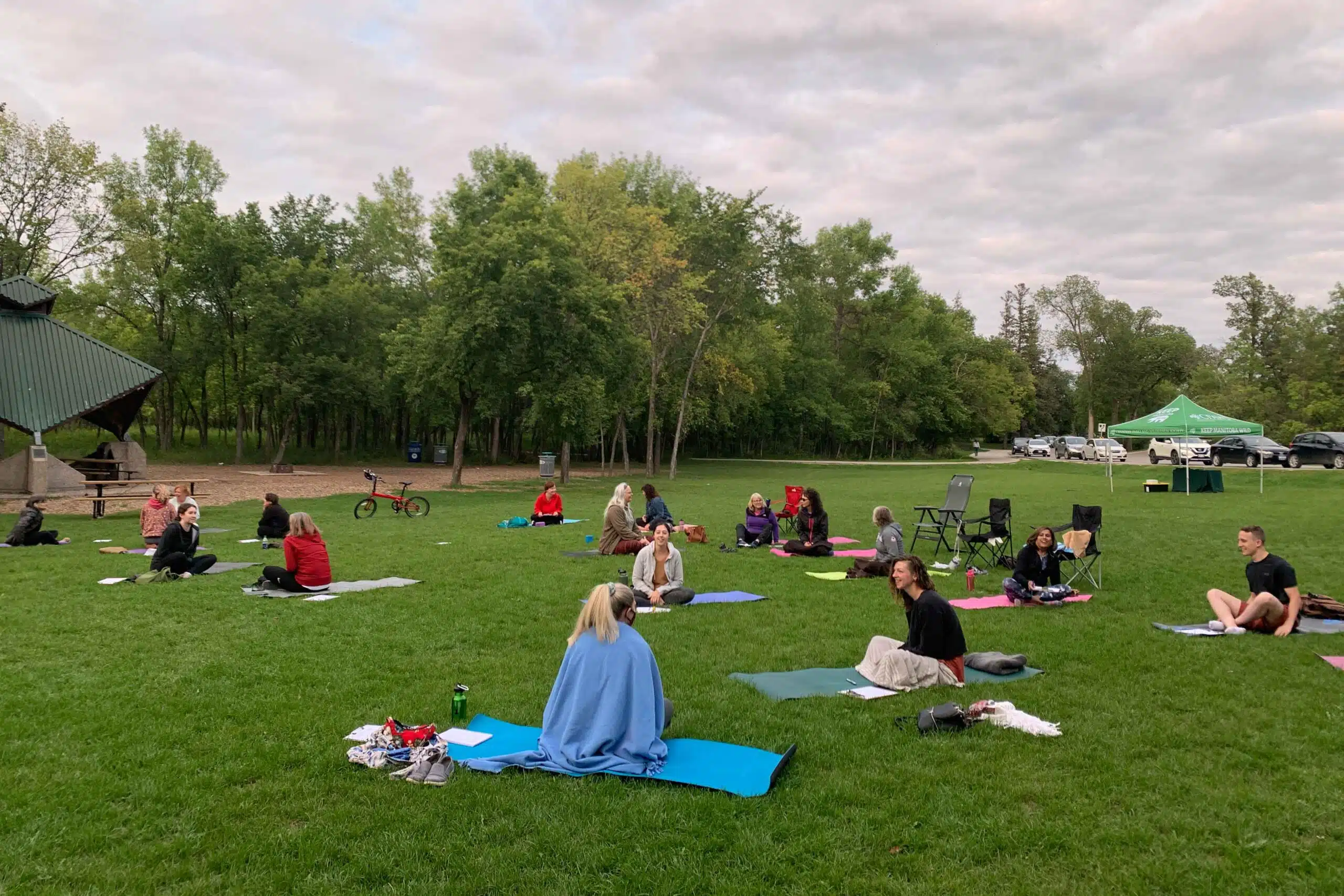
By Avery Kash, Environmental Educator, CPAWS Manitoba
When was the last time you took a walk in the woods with no final destination, with no lookout to conquer, no time frame, and no goals?
What about when was the last time you simply sat with yourself and checked in with your five senses at that moment?
If a time doesn’t come to mind, that’s OK. In the hustle and bustle of everyday life, it’s easy to get caught up in schedules, goals, and crossing things off your to-do list rather than simply being.
We wanted to create the opportunity for Manitobans to connect with nature, which is why we launched our Nature Club workshops at Assiniboine Park.
Our forest bathing and mindfulness workshops (led by me, Avery Kash!) have sold out quickly, and it’s so powerful to connect with each other and to the spirit of nature.
The workshop begins with a meditation to connect with the senses, followed by an exploration of forest bathing. We spend time exploring the surrounding forest, sitting and hugging trees and finish with a slow flow restorative yoga practice.
“This workshop helped me to relax and really see my environment for the first time in a while,” said one participant. “I left feeling refreshed and aware of my surroundings in a whole new way.”
Here are some key takeaways from the workshop that you can apply to your life to support your mental health and well-being.

Avery Kash led a group through a mindfulness, forest bathing, and yoga workshop in August 2021.
What is Mindfulness?
Mindfulness is when our mind is fully aware of what is happening and what we are doing. We’re fully present, aware of where we are and what we’re feeling. We notice our reactions. We notice the feelings in our body. We approach our experience without judgement. We are here.
To me, mindfulness begins in the body. When we think about meditation and mindfulness, we think about our racing thoughts and calming our brain. But what if we connect to our body, to our senses first? Mindfulness is about grounding into the present moment, to notice what we’re feeling and what we’re experiencing, without judgement.
What is Forest Bathing?
When I first heard the term “forest bathing,” I immediately imagined a clawfoot tub filled with warm water, and maybe some bubbles, in the middle of the forest. That sounds very peaceful but not particularly achievable.
But that’s not what forest bathing is. At least not the forest bathing I’m referring to!
Forest bathing, or forest therapy, was developed in Japan in the 1980s. Forest bathing is translated from the Japanese term shinrin-yoku. Japan is known for its demanding work environment — the term karoshi means death by overwork.

Photo by Kevin Kash.
Forest therapy has become an integral part of preventative health care and healing in Japanese medicine because of the scientific evidence of the health benefits of spending time in nature.
Forest bathing is not hiking. It’s not about following a defined route. While hiking involves moving purposefully, forest therapy walks move much slower. A one-kilometre walk could take two hours.
The point is not the destination; the point is to focus on the details of the journey. It’s not about identifying the species around you. Rather, it’s about contemplating what you see around you.
What are the colours, the textures, the sounds? You might use your eyes, paying attention to what’s in motion — noticing birds flying, the wind moving the leaves, the caterpillar moving across the leaf.
Forest bathing can be guided or independent. However you choose to approach forest bathing, the first step is opening yourself up to it. Give yourself permission to slow down, to be right here, to connect to your body, your senses, and this experience.
Some of my personal practices involve:
- Touch and texture;
- Putting my hand on trees to listen to their wisdom;
- Walking barefoot in the mossy forest;
- Noticing smells; and
- Sitting in silence against a tree, being held and supported by the Earth.
Essential oils are also really lovely to add to your forest bathing practice — if you have bracelets with lava stone, you can infuse them with your favourite essential oil to add to your experience.
Forest bathing can be done in any green space. You don’t need to drive three hours outside of the city. You can forest bathe in your backyard or in a park along the river. You don’t need special skills or tools to dive into this practice.
And you definitely don’t need a clawfoot tub in the middle of the forest.
Forest bathing works best as a form of prevention and a way to retain a healthy mind and body. It is not a replacement for medical advice or counselling for those who are seriously ill.

Photo by HAN Mengqi on Unsplash.
Research Supports Forest Bathing Benefits
There is an enormous amount of scientific evidence documenting the health benefits of spending time in nature and mindfulness practices. The studies are growing and evidence is expanding.
Spending time in nature has been shown to:
- Reduce stress;
- Improve immunity;
- Improve mental health;
- Improve concentration;
- Improve sleep; and
- Increase happiness, just to name a few!
Even just 20 minutes outdoors a day can support our mental health and well-being.
Healing Forest reports forest bathing benefits include:
- Learning to switch off unwanted thoughts;
- Increased self-worth and confidence;
- Overcoming fear, self-doubt, depression, anxiety, and worry;
- Improved sleep and rest;
- Finding peace and happiness in the present moment;
- Increased empathy and improve relationships;
- Enhance emotional intelligence; and
- Boosted creativity.
Spending time in a natural setting (especially under a forest canopy) is rejuvenating to the mind, body, and spirit.
Meet Avery Kash

Photo of Avery Kash by Kevin Kash.
A former high school teacher, I work with CPAWS Manitoba as our environmental educator, combining my love for education and nature. I am a 200-hour registered yoga teacher from Manitoba. In my yoga and mindfulness classes, I like to invite participants to courageously connect to their heart while bringing softness, stillness, and connection to the mind and body. You can read more about me and the work I do with CPAWS Manitoba in this blog post.
About the CPAWS Manitoba Nature Club
This workshop was part of the CPAWS Manitoba Nature Club, which has three main components: Outdoor Learning (workshops fall under this), Outdoor Fun, and Speaker Series.
Our Nature Club is designed to help Manitobans get outside, make new friends, and learn about the wonders of nature.
Click here for the full Nature Club event listings.
